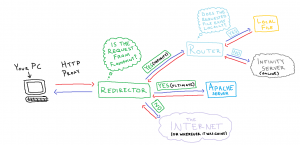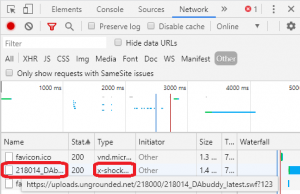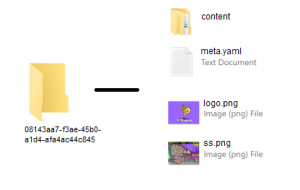User talk:ThePowerPlayer
This page is a basic tutorial on how Flashpoint works and how to curate games to add them to Flashpoint.
For more advanced platform-specific tutorials, see Platforms.
For more details on how to package a curation, see Curation Format.
How Flashpoint Works
Before you start curating a game, it's important to understand exactly how Flashpoint works.
See, Flashpoint is more than just a game launcher; rather, it's a combination of three programs working in parallel:
- a web server, which hosts game files from a hard drive and pretends to be the original Internet source the games ran off of,
- a redirector, which points the game files and resources to the server to make them believe they're on the Internet,
- and a launcher, the user interface to select and play games from.
All versions of Flashpoint use these programs, but Flashpoint itself also comes in three primary versions:
- Infinity, the version that downloads games from online as you play them,
- Ultimate, the gigantic version with every game included and ready for offline play,
- and Core, the version similar to Ultimate with only a few games for testing. It is most often used by Curators to add games.
Infinity will download files as you play games that request them, while Ultimate and Core know the files are already there. All three make the files believe they're being ran on their original source. This has numerous benefits, the two most important being supporting multi-asset games and bypassing sitelocks. For now, though, let's walk through curating a single-asset SWF file.
Setting Up Our Software
To download game files from the Internet, you'll need:
- Flashpoint Core, used to add and test new games. You can find it at the bottom of the Downloads page.
- A modern browser such as Chrome or Firefox, which have a built in Network monitor that we can use to find and grab individual SWFs and sometimes multi-asset titles with low amounts of resources.
There are more tools that you can use, but since we're not dealing with multi-asset games yet, we'll just use these two for now. Download Flashpoint Core, extract it to your hard drive, run it via its shortcut in the extracted folder, and make sure that the included games play properly before you continue.
Grabbing Our First Game From The Internet
As a tutorial, we'll start by curating the simplest type of curation for beginners: a single SWF file that isn't sitelocked, specifically Interactive Buddy. You might need to enable Flash in your browser to get it to play (this tutorial won't work if you're using another Flash player such as the Newgrounds Player).
If you're using Chrome or Firefox, press F12 to open the Developer Tools and click on the Network tab. This shows us every asset that loads on the page in real time. You can filter miscellaneous types of assets such as Flash files by clicking the Other tab within the Network tab. Refresh the page, and you'll likely find a few assets, but the game file has an extension of .swf and a type of x-shockwave-flash in the table. Once you find the SWF, you can hover over it to see its URL and confirm that it ends in .swf. Right click the asset in the table and click Copy > Copy link address.
You can continue in a variety of ways, but it's best to learn manual curation for single-assets before moving on. To do that, paste your URL into a new tab and download the Interactive Buddy SWF. Don't rename it, and save it in any location for now.
Setting up any curation takes more than a game file; as shown on the right, it involves a couple extra files. We want to pay attention to the first two in particular:
- The content folder, which contains a series of folders leading to our SWF;
- and the meta.txt, containing metadata used both to distinguish one curation from another and for informative purposes.
Open Notepad or another text editor and create a new file named meta.txt. This will contain many fields to fill out about your game, but these are the most important ones:
- The "Title", which tells the game apart from others. Name it "Interactive Buddy" or "Test Game" or anything you like, it doesn't matter right now.
- The "Platform", which determines where the game goes inside our database, split into several platforms (Flash, Shockwave, Unity, etc). When using Core for testing purposes, this isn't massively important, but Flash is selected for SWF files and by default.
- The "Application Path". This determines what piece of software is used to start up the file we specify. In this case we're using a single, simple SWF, so we'll use the Flash Player Projector; in the current version of Core, this is listed as "FPSoftware\Flash\flashplayer_32_sa.exe", so use that.
- The "Launch Command", based on the URL of the game's source file.
Here's the link to the SWF for Interactive Buddy:
https://uploads.ungrounded.net/218000/218014_DAbuddy_latest.swf?123
We need to create a Launch Command inside our fake internet for our Flashpoint Core to load in the same way as a URL, so let's put one together, piece by piece.
First of all, be extremely careful about the beginning of the URL; it uses HTTPS instead of HTTP. Flashpoint can't handle using HTTPS, and will download assets from the live Internet instead of from its fake Internet server, which can lead to a game going off the web later and not working in Flashpoint when that happens. To summarize, always use http:// at the beginning of a Launch Command, NO EXCEPTIONS.
http://
After that comes the primary domain of the URL, which is in this case uploads.ungrounded.net;
http://uploads.ungrounded.net
Every slash (/) after http:// and the primary domain represents the beginning of a subdomain, eventually leading to our SWF. The next subdomain here is 218000;
http://uploads.ungrounded.net/218000
Finally, the subdomain 218000 contains our SWF file;
http://uploads.ungrounded.net/218000/218014_DAbuddy_latest.swf
This is a complete Launch Command telling Flashpoint where to find our game. To summarize, the Launch Command of a game is most often the URL of its source file, but always using http:// instead of https://.
In your meta.txt, write your metadata fields something like this:
Title: Interactive Buddy Platform: Flash Application Path: FPSoftware\Flash\flashplayer_32_sa.exe Launch Command: http://uploads.ungrounded.net/218000/218014_DAbuddy_latest.swf
Again, there will eventually be more metadata fields in your curation, but these ensure the game will work in Flashpoint.
Now it's time to create your content folder. Create a new folder named "content" (in lowercase). The subfolders within this folder are named after the main domain, then each subdomain of the Launch Command, until you get to the SWF itself. In this case, create a folder named uploads.ungrounded.net inside the "content" folder. Go into that new folder and create another named 218000, then move the SWF you downloaded earlier into the 218000 folder.
Curating with Flashpoint Core
Once you've created both your meta.txt and content folder, put them in the same folder and name it whatever you like. Open Flashpoint Core and click the Curate tab. Click "Import Folder" and go to the folder you just created, then click "Import All". Flashpoint will automatically add your curation unless you've made an error with your Application Path or Launch Command. Go to the Games tab, double-click your game to test it, and you should see Interactive Buddy pop up.
Congrats! You've successfully made a curation. Now let's see how to deal with more complex games.
Sitelocks
Some Flash games will check the domain the game is being hosted on, and "lock" the game from being played if it's not on the correct site, called a sitelock. This can even occur, though very rarely, to the original site the game was hosted on, as is the case with Monster Slayers. Click this link and try to play the game; your result will be the image on the right. Despite the game already being hosted on andkon.com, it'll activate its sitelock and tell you to go to Andkon Arcade. Try to find and download the SWF using the method described in the previous section.
You should find this source URL:
http://andkon.com/arcade/adventureaction/monsterslayers/monsterslayers.swf
This ironic sitelock is due to Andkon's main domain changing to "andkon.com", when it used to be "arcade.andkon.com". Therefore, changing the "andkon.com" in the URL to "arcade.andkon.com" will give us a Launch Command that bypasses the sitelock:
http://arcade.andkon.com/arcade/adventureaction/monsterslayers/monsterslayers.swf
This particular URL uses http:// instead of https://, but always make sure the Launch Command uses http:// regardless.
You can use a different curation folder or the same one as before, but make sure to use this correct Launch Command. Import your curation into Core again and test your game; Flashpoint should bypass the sitelock and allow you to play the game as Andkon once did.
It's important to use correct Launch Commands and proper content folders for every curation you make (even if you're curating a non-sitelocked SWF), to ensure that all the game's assets are loaded exactly as they would be on the real Internet, without running into any possible sitelocks on the way (even if the game appears to be playable outside of Flashpoint).
Using cURLs Downloader for Multi-Asset Games
Up until now, we've only curated single-asset SWF files. However, many games were made at a time where downloading one large file was a large pain, and so games were split into several, smaller assets. Whether these games load all of the assets at once or if they load assets as you play the game depends on how they were programmed, making curation of multi-asset games more difficult than single-assets.
If while testing a seemingly single-asset game, you get stuck when you should clearly be able to continue, check the Redirector window for anything labeled (404 Not Found). This means the game was calling for one or more assets that it didn't have offline, making the game freeze because it failed to load a required assset. Thankfully, Flashpoint can handle these assets as long as they're downloaded properly.
Instead of manually downloading lots of assets, this time we'll use a program called cURLs Downloader.
Option 1: Download assets called by the game as you test it in Flashpoint Core.
- cURLs Downloader should be in your Flashpoint Core folder > Utilities > cURLsDownloader.
- In the Redirector, select Copy > Copy all 404 Not Found URLs and paste the results into a text file.
- Save the text file and drag it over cURLs Downloader.
- Wait for cURLs Downloader to finish fetching assets. Use option 1 when finished if it detects broken filenames, which will very likely fix them.
- Copy the contents of the Downloads folder in cURLs Downloader to a new content folder.
- Delete your old curation and re-import with the new content. Test your game and repeat if the game 404s on additional assets.
Option 2: Download all the assets the source page of a game loads as you play it on the live Internet (but some assets downloaded won't be part of the game).
- Once again, open the Network viewer and refresh the page.
- When you're confident you've loaded all a game's assets on its original Internet source, click the "All" tab in the Network viewer this time and right-click on an asset.
- Select Copy > Copy all as cURL (cmd) and paste the results into a text file.
- Save the text file and drag it over cURLs Downloader.
- Wait for cURLs Downloader to finish fetching assets. Use option 1 when finished if it detects broken filenames, which will very likely fix them.
- Open the Downloads folder in cURLs downloader and determine which folder contains the necessary files to play the game.
- Copy the contents of your chosen folder in cURLs Downloader to a new content folder.
- Delete your old curation and re-import with the new content. Test your game.
When testing games, if a game lets you get through more than one level without loading another asset, you'll generally be okay to assume that there's no more assets to be found, but this is never a guarantee, and you should always test your game in Flashpoint as much as you can.
Wrapping It Up
Try curating your own game now that you know about curation. Be sure to check the Game Master List before curating! Otherwise, you might waste time and effort to save a game that's already been saved.
If you think your game might not be a Flash game, try viewing the tutorials for other Platforms like Shockwave or HTML5. If you know your game is Flash but still can't get it to work, check the Flash Curation page for more detailed info on specifically Flash games. If all else fails, ask away in #curator-lounge on our Discord and we'll try to solve the issue together.
Once you're sure you've gotten a game working in Flashpoint, it's time to add the additional parts of any curation. The Curation Format page tells you how curations are laid out in order to add it to the master build of Flashpoint with as much information as possible. Once you have a proper curation ready, follow these steps to make sure it gets added to Flashpoint:
Submitting a Curation
Submissions are uploaded in the Flashpoint Submission System, which requires you to join our Discord server first. An explanation of how the site works is available here.
If you have any questions, ask in #curators and a Curator will answer them.
After you have uploaded your curation to the website, a Curator will check it. This can take some time, so please be patient. You will be pinged in #fpfss-notifications about whether or not your submission was approved, and if any changes need to be made.
Once your first submission is approved, you'll be given the Trial Curator role. That means you will be able to submit more curations and upload bigger files.
Congratulations! Your submitted game/animation will be available to anyone using Flashpoint Infinity once a staff member marks it as "Added to Flashpoint". For users using Flashpoint Ultimate, it will appear in the next update.




